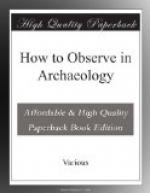[1] The western custom of cremation was never adopted, in spite of the Hellenization of culture. It offended both Babylonian and Iranian sentiment, although the Parthians were never very orthodox followers of Ahuramazda, and venerated (at least platonically) the most popular deities of the Greek pantheon.
2. Sassanian Period; c. 220-650 A.D.
Characteristics. Reaction towards Oriental motives in art: a typical antika of the period is the Sassanian seal of cornelian, chalcedony, or haematite, in shape sometimes a ring, more often a flat sphere with one-third cut off to form a seal-base, perforated for stringing (see XIV, Fig. 8), and inscribed in Pehlevi (see XV, Fig. 20) a script that to the unitiated looks very like Cufie Arabic: the language is Old-Persian, which was spoken by the court officials at Ctesiphon, the language of the people being Aramaic. Sculpture barbarized, but with a picturesque character of its own (Nakhsh-i-Rustam, Tak-i-Bostan), sometimes reminiscent of Indian work. Architecture: Parthian-Roman traditions (Ctesiphon). Pottery usually glazed blue (thicker glaze). Unglazed bowls with Hebrew and Mandaitic magical inscriptions. Bronze no longer used except for coins. Objects from mounds very like those of preceding age, but less of Roman origin. Not much known of burials; the Warka slipper-coffins usually regarded as Parthian may possibly be of early Sassanian age.
VII. LATER IRON AGE: Muhammadan Period; c. 650-1500 A.D.[1]
Characteristics. Development of art under Persian influence till Tartar conquest in thirteenth century: the destruction and depopulation of the country at that time brought all real artistic development to an end. Flourishing period: the ’Abbasid Khalifate: ninth century: Harun al-Rashid. Ruins of the ancient city and palaces of Samarra: halls with modelled and painted plaster-decorations, not only geometrical but also (Persian heterodox influence) representing trees, birds, &c. No more sculpture in round or relief of human figures or animals. The only survival of classical tradition would appear to be to some extent in architecture: Greek architects.




